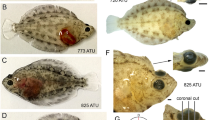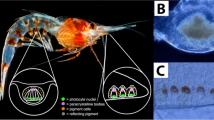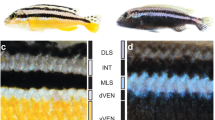Abstract
THE retinae of the rudd contain more of the visual pigment VP1507 in the summer, but more of VP2535 in the winter1. The interconversion is shown to be governed by the local light environment2 since it can be effected in one of the two eyes by occluding it. Thus, light must act directly, and not, for example, by some humoral process. No action spectrum of the process is available for this species (but see ref. 3), an essential for the understanding of such phenomena4, but the fact that only relatively young members of this species can achieve the conversion2 is significant. Individuals seven years old or more keep VP2535 throughout the year. This “winter” pigment occurs in the retinae of young fish only after about one month's stay in the dark, or if the corresponding corneae are occluded.
This is a preview of subscription content, access via your institution
Access options
Subscribe to this journal
Receive 51 print issues and online access
$199.00 per year
only $3.90 per issue
Buy this article
- Purchase on Springer Link
- Instant access to full article PDF
Prices may be subject to local taxes which are calculated during checkout
Similar content being viewed by others
References
Dartnall, H. J. A., Lander, M. R., and Munz, F. W., Progress in Photobiology (edit. by Christensen, B. Chr., and Buchmann, B.) (Elsevier, Amsterdam, 1961).
Bridges, C. D. B., and Yoshikami, S., Vision Res., 10, 1315 (1970).
Allen, D. M., Vision Res., 11, 1077 (1971).
Weale, R. A., Photophysiology IV (edit. by Giese, A. C.) (Academic Press, New York, 1968).
Bridges, C. D. B., and Yoshikami, S., Vision Res., 10, 1333 (1970).
Dodt, E., and Walther, J. B., Pflügers Archiv, 266, 167 (1958).
Weale, R. A., The Aging Eye (H. K. Lewis, London, 1963).
Denton, E. J., Bull. Inst. Océan., 53, No. 1071 (1956).
McCandless, R. L., Hoffert, J. R., and Fromm, P. O., Vision Res., 9, 223 (1969).
Witkovsky, P., Vision Res., 8, 823 (1968).
Burkhardt, D. A., Vision Res., 6, 517 (1966).
Muntz, W. R. A., and Northmore, D. P. M., Vision Res., 10, 281 (1970).
Fink, H., Hockwin, O., and Weigelin, E., Ophthal. Res., 1, 321 (1970).
Weale, R. A., Optica Acta, 1, 107 (1954).
Mellerio, J., Vision Res., 11, 129 (1971).
Walsh, J. W. T., The Science of Daylight (Macdonald, London, 1961).
Judd, D. B., Color in Business, Science and Industry (Chapman and Hall, London, 1952).
Author information
Authors and Affiliations
Rights and permissions
About this article
Cite this article
VILLERMET, G., WEALE, R. Age, the Crystalline Lens of the Rudd and Visual Pigments. Nature 238, 345–346 (1972). https://doi.org/10.1038/238345a0
Received:
Revised:
Issue Date:
DOI: https://doi.org/10.1038/238345a0
This article is cited by
-
Patterns of pigmentation in the eye lens of the deep-sea hatchetfish,Argyropelecus affinis Garman
Journal of Comparative Physiology A (1986)
Comments
By submitting a comment you agree to abide by our Terms and Community Guidelines. If you find something abusive or that does not comply with our terms or guidelines please flag it as inappropriate.



